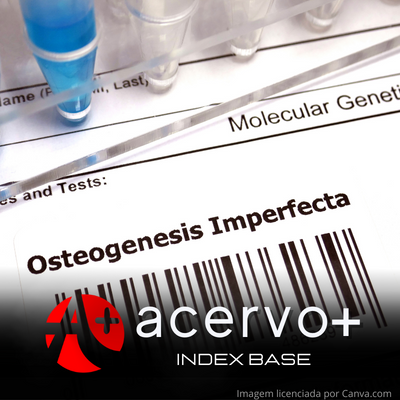Uma abordagem geral da Osteogênese imperfeita
##plugins.themes.bootstrap3.article.main##
Resumo
Objetivo: Analisar as características da Osteogênese Imperfeita (OI). Revisão bibliográfica: A OI é um distúrbio sistêmico do tecido conjuntivo caracterizado por baixa massa óssea e fragilidade óssea, causando morbidade significativa devido à dor, imobilidade, deformidades esqueléticas, fraturas e deficiência de crescimento. Sua incidência é de 1 em 10.000 a 1 em 20.000 nascimentos e no Brasil há cerca de 12 mil pessoas portadoras da doença. A maioria da OI (cerca de 85-90% dos casos) está associada a variantes patogênicas hereditárias autossômicas dominantes nos genes do colágeno tipo I. A OI possui alta incidência de fraturas que podem ocorrer com mínimo ou nenhum trauma, além de poderem envolver localizações atípicas. Considerações finais: A osteogênese imperfeita é uma doença genética dos tecidos conjuntivos causada por uma anormalidade na síntese ou processamento do colágeno tipo I, sendo conhecida também como ossos de vidro. Esta doença possui um manejo desafiador pelo seu amplo espectro genético e fenotípico. Atualmente, as opções de tratamento disponíveis para OI incluem prevenção de fraturas ósseas, controle dos sintomas, prevenção e tratamento das complicações, principalmente as respiratórias e aumento da massa óssea.
##plugins.themes.bootstrap3.article.details##
Copyright © | Todos os direitos reservados.
A revista detém os direitos autorais exclusivos de publicação deste artigo nos termos da lei 9610/98.
Reprodução parcial
É livre o uso de partes do texto, figuras e questionário do artigo, sendo obrigatória a citação dos autores e revista.
Reprodução total
É expressamente proibida, devendo ser autorizada pela revista.
Referências
2. BESIO R, et al. Bone biology: insights from osteogenesis imperfecta and related rare fragility syndromes. FEBS J, 2019; 286(15): 3033-3056.
3. BOTOR M, et al. Osteogenesis Imperfecta: Current and Prospective Therapies. Biomolecules, 2021; 11(10): 1493.
4. CARRÉ F, et al. Hearing impairment and osteogenesis imperfecta: Literature review. Eur Ann Otorhinolaryngol Head Neck Dis, 2019; 136(5): 379-383.
5. CLAEYS L, et al. Collagen transport and related pathways in Osteogenesis Imperfecta. Hum Genet, 2021; 140(8): 1121-1141.
6. CHO TJ, et al. Management of Osteogenesis Imperfecta: A Multidisciplinary Comprehensive Approach. Clin Orthop Surg, 2020; 12(4): 417-429.
7. DEGUCHI M, et al. Current Overview of Osteogenesis Imperfecta. Medicina (Kaunas), 2021; 57(5): 464.
8. EL-GAZZAR A e HOGLER W. Mechanisms of Bone Fragility: From Osteogenesis Imperfecta to Secondary Osteoporosis. Int J Mol Sci, 2021; 22(2): 625.
9. ETICH J, et al. Osteogenesis imperfecta-pathophysiology and therapeutic options. Mol Cell Pediatr, 2020; 7(1): 9.
10. HARSEVOOT AGJ, et al. Fatigue in adults with Osteogenesis Imperfecta. BMC MusculoskeletDisord, 2020; 21(1): 6.
11. JOVANOVIC M, et al. Osteogenesis Imperfecta: Mechanisms and Signaling Pathways Connecting Classical and Rare OI Types. Endocr Rev, 2022; 43(1): 61-90.
12. LOMAURO A, et al. Eat, breathe, sleep with Osteogenesis Imperfecta. Orphanet J Rare Dis, 2021; 16(1): 435.
13. MAROM R, et al. Osteogenesis imperfecta: an update on clinical features and therapies. Eur J Endocrinol, 2020; 183(4): 95-106.
14. MARTINS G, et al. Bladder and bowel symptoms experienced by children with osteogenesis imperfecta. Jornal de Pediatria, 2020; 96(4): 472-478.
15. MORELLO R. Osteogenesis imperfecta and therapeutics. Matrix Biol, 2018; 71-72: 294-312.
16. NATARAJAN SB e BAALANN KP. Osteogenesisimperfect. Pan Afr Med J, 2021; 40: 98.
17. NGUYEN HTT, et al. Dentinogenesis Imperfecta and Caries in Osteogenesis Imperfecta among Vietnamese Children. Dent J (Basel), 2021; 9(5): 49.
18. NIJHUIS WH, et al. Current concepts in osteogenesis imperfecta: bone structure, biomechanics and medical management. J Child Orthop, 2019; 13(1): 1-11.
19. ROSSI V, et al. Osteogenesis imperfecta: advancements in genetics and treatment. Curr OpinPediatr, 2019; 31(6): 708-715.
20. ROUSSEAU M, et al. Osteogenesis imperfecta: potential therapeutic approaches. PeerJ, 2018; 6: e5464.
21. TAUER JT, et al. Osteogenesis Imperfecta: New Perspectives From Clinical and Translational Research. JBMR Plus, 2019; 3(8): e10174.
22. TAQI D, et al. Osteogenesis imperfecta tooth level phenotype analysis: Cross-sectional study. Bone, 2021; 147: 115917.
23. TRANCOZO M, et al. Osteogenesis imperfecta in Brazilianpatients. Genet Mol Biol, 2019; 42(2): 344-350.
24. VITTURI BK, et al. Osteogenesis imperfecta. Autops Case Rep, 2018; 8(3): e2018040.
25. ZARIPOVA AR e KHUSAINOVA RI. Modern classification and molecular-genetic aspects of osteogenesis imperfecta. VavilovskiiZhurnal Genet Selektsii, 2020; 24(2): 219-227.

